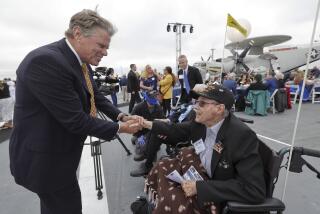Waves on the runway and nostalgia in the air : Miami seaplane rides are like flying in a dream. Pilots say the thrills leave other planes in their wake.
- Share via
MIAMI — The flight begins almost like an amusement park ride, with a thrill. Water splashes over the windows, the engines growl overhead and the plane bucks through the waves like a tail-heavy goose. Within seconds, the 45-year-old Grumman Mallard begins to rise over Biscayne Bay, over the decks of an outbound cruise ship, over gravity, over all but the clouds.
Another seaplane operated by Chalk’s International Airline--the oldest continuously operating airline and the last airboat airline in the world--is airborne. Destination: the ocean off Key West.
“This is really flying,” says pilot Bob Peloquin, who is also Chalk’s operations director. “Every landing and takeoff is different, and I think the passengers and the pilots enjoy that feeling of excitement.”
Since 1919, Chalk’s seaplanes have been as much a symbol of Miami as cable cars are of San Francisco. Founded when barnstormer Arthur B. (Pappy) Chalk poked a beach umbrella into the downtown Miami sand and offered $5 sightseeing tours, the airline over the years has had its share of famous passengers: Lana Turner, Errol Flynn, Ernest Hemingway; famous owners: Donald Trump, Merv Griffin; and financial woes.
The little airline with a one-room terminal has also enjoyed plenty of publicity. Its airboats in recent years have been featured in “The Silence of the Lambs,” a George Michael music video and several episodes of “Miami Vice.”
What Chalk’s has never had, in 73 years of operation, is a fatal accident. The airline’s new owners, United Capital Corp. of Illinois, vow to keep that record and its fleet of five seaplanes intact.
In an aviation age of high-tech and consolidation, Chalk’s has survived as the prototypal niche airline, going where others cannot, ferrying fishermen to tiny out-islands in the Bahamas, landing anywhere in Florida or the Caribbean where pilots can find water at least two feet deep. In addition to charters, the company has long offered daily service to Nassau and Bimini in the Bahamas. Five round trips a week to Key West (cost: $139) were begun last year.
Chalk’s president, Seth Atwood, says the firm is exploring the possibility of starting service to Catalina Island from Long Beach harbor next summer.
The journey from Miami to Key West goes right down the spine of the Florida Keys, from Key Largo to Key West, paralleling the Overseas Highway, a ribbon of pavement that links island to island for 150 miles. At an altitude of 700 feet, passengers can almost pick out the dolphin and grouper in the turquoise waters of the Atlantic, count the leaves on the mangrove trees, see the envy on the faces of motorists making the tedious four-hour drive.
For most passengers, the 55-minute flight is less transportation than adventure. “It’s a blast,” said Miami business executive Valerie MacLaren, heading to Key West. “I wouldn’t mind if they just did the landings and takeoffs over and over.”
Although the planes have been refurbished and the engines retooled as turboprops, the Mallards are working history, 1940s vintage. Inside the cabins, the 17 seats are upright, covered with aqua vinyl. The decor is distinctly Margaritaville, with pastel sunsets and colorful maps of the Keys hand-painted on canvas.
There are no flight attendants, no refreshments, fold-down trays or air conditioning. There are air vents to the outside.
There is no door to the cockpit. Passengers can see the pilot and co-pilot, both in shorts and deck shoes, flipping switches, steering around thunderstorms, thumbing through guidebooks in search of amusing or historical anecdotes to relay to the sightseers.
Chalk’s faces tough competition on the Miami-Key West route from several large airlines, but since water landings began July 1--after right-of-way problems forced the airline to use Key West Airport for 12 months--occupancy is up, Peloquin says.
“There is an entertainment aspect to our airline, with the feel of a Disney experience,” says Peloquin. “Compared to flying with us, being on a big commercial jet is like being on a bus.”
Virtually the only close calls Chalk’s has recorded have been due to outside forces. In 1933, Cuban dictator Gerardo Machado summoned a Chalk’s seaplane to get him off the island after a coup. The plane took off in a hail of bullets, but the ousted leader, described as “retired” on the manifest, arrived safely in Miami.
And in May, 1972, two armed men shot and critically wounded a pilot and mechanic while commandeering one of the Grummans that was readying for a trip to Bimini. Despite gunfire from Miami police, the gunmen forced the pilot and five passengers to go to Cuba. The plane returned the next day, sans hijackers.
In Key West, the Mallard drops down into crystalline waters behind tiny Christmas Tree Island and surfs up to the beach. The passengers climb out and board an open boat for a 10-minute water taxi ride to the pier at the foot of Duval Street. The co-pilot goes along to help with the luggage.
“No airports, no lines, and we’re right downtown on the dock, in the Caribbean,” says pilot Paddy O’Leary. “There’s the nostalgia of it too. Folks have seen these airboats in old movies; they like the romantic adventure of it. And now they’re in it. That’s what people like.”
More to Read
Sign up for The Wild
We’ll help you find the best places to hike, bike and run, as well as the perfect silent spots for meditation and yoga.
You may occasionally receive promotional content from the Los Angeles Times.






